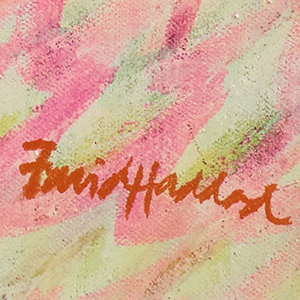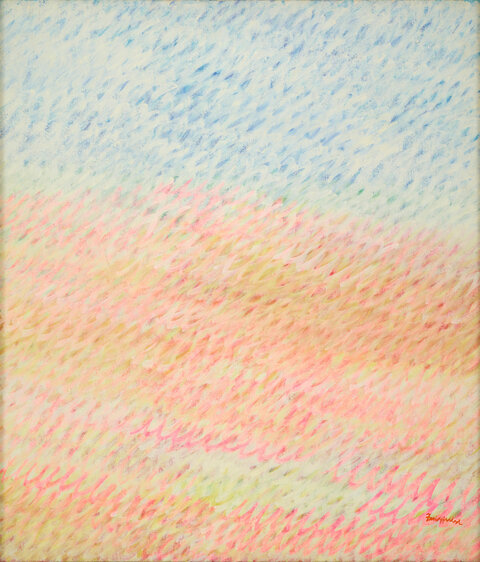Farid Haddad was born in 1945 in Beirut, Lebanon. Though raised in a family of scientists and businessmen, Haddad was drawn to art from a very young age. Though his first interest was music, he...


FARID HADDAD, Lebanon (1945)
Bio
Written by ZEID EL AMINE
Farid Haddad was born in 1945 in Beirut, Lebanon. Though raised in a family of scientists and businessmen, Haddad was drawn to art from a very young age. Though his first interest was music, he enrolled in painting classes at Omar Onsi’s studio at the Gudver Institute in the early ‘60s, where he fell in love with the visual arts. In 1969, he graduated with a Bachelor of Fine Arts from the American University of Beirut, where he was mentored by American artists Arthur Frick and John Carswell, and later received his MFA from the University of Wisconsin-Milwaukee.
In 1972, Haddad spent six months in New York through a Fulbright scholarship. Four years later, the artist began teaching drawing and painting at the University of Wisconsin-Milwaukee, and in 1979, design and multimedia art at the New England College in Henniker, New Hampshire, where he earned the State Council of the Arts Prize in 1983 and 1984.
At the start of his career in the 1970s, the artist applied in his work the principles of color-field painting, a style of abstraction established in New York in the late 1940s. Typically made on a large scale, color-field paintings involve the use of overlapping pigments painted or stained into the canvas in broad swaths of unbroken color, emphasizing the flatness of the picture plane and negating all forms of figuration. Here, the importance is not given to form, composition, and brushstrokes in the intention to center color itself as the “subject” of the painting. While Haddad’s works derive from this movement, they do not stick rigidly to its principles and can be interpreted beyond the scope of pure color, evoking landscapes in their allusions to romantic green fields and dreamy skies. For example, in Color Field Variation no. 4 (1973), the artist ornaments a landscape with powerful contrast. Colors gradate from an exploding red at the bottom of the canvas to a mellow blue-green at the top. In contrast to the color field painters of the 1940s and 1950s, his rhythmic paint strokes are immediately visible throughout the artwork, applied repetitively and meditatively in the same direction. Celebrated Lebanese-American artist and critic Helen Khal (1923-2009) described these works as intellectually provocative and emotionally satisfying. As a result of his stylistic choices during this period, critics compared him to Jack Tworkov, an American-Polish abstract expressionist painter.
In the early eighties, Farid Haddad turned to experimental abstraction. His new works were characterized by a dominance of color over loose shapes, and extensive hatching and brushstrokes that cover his canvases to form exciting textures that resemble wrinkled paper from a distance. He continued in this aesthetic vein through the 2000s, as is seen in Mahalia’s Landscape (2005). Here, the figureless background is colored with an autonomous white and tainted with greyish yellow and blue. A chopped tree trunk is freely depicted on the central right of the canvas. The thickness of the paint and the intensity of Haddad’s brushstrokes give the painting a sense of antiquity.
In some of his works, Haddad paints a square in the middle of the composition, seemingly out of place. In Cathedral (1979), for example, a flatly-colored orange square is centered amid a fusion of breath-taking indigo. The painter justified his use of the geometric shape as an attempt to create “one painting within an another,” adding that “there is a perversity in that square, it tortures me; I would love right now to be able to peel that square off.”
Farid Haddad has participated in more than 20 solo exhibitions and over 50 group exhibitions in Europe, the Middle East, and the United States. Today, he is Professor Emeritus at New England College, where he is known among his students and colleagues for his dry humor and passion for teaching. Haddad works out of his studio in Concord, New Hampshire.
Sources
Abillama, Nour.S & Tomb, Marie. Art From Lebanon: Modern and Contemporary Artists 1880-1975.Beirut: Wonderful Editions, 2012.
Nammour, Cesar & Schaub, Gabriela. Resonances. 82Lebanese artists reviewed by Helen Khal.Beirut: Fine Arts Publishing, 2011.
“Color Field Painting.” The Art Story. https://www.theartstory.org/movement-color-field-painting-artworks.htm
“A Movement in a Moment: Color Field Painting.” Phaidon. https://uk.phaidon.com/agenda/art/articles/2017/april/10/a-movement-in-a-moment-colour-field-painting/
CV
Selected Solo Exhibitions
2023
Farid Haddad: Pour l'âge du Liban, Sfeir-Semler Gallery, Beirut, Lebanon
2007
Farid Haddad: Selected Works on Paper 2001-2006, New England College Art Gallery, Henniker, New Hampshire, USA
1993
Farid Haddad: Recent Drawings, New England College Art Gallery, Henniker, New Hampshire, USA
1992
Farid Haddad: La période des années 70, Agial Art Gallery, Beirut, Lebanon
1986
Farid Haddad: Opere recenti, MR Arte Contemporanea, Rome, Italy
1983
Farid Haddad: Recent Paintings and Drawings, Michael H. Lord Gallery, Milwaukee, Wisconsin, USA
1981
Haddad: 10 Portes de Jérusalem et œuvres récentes, Galerie Faris, Paris, France
Farid Haddad: New Paintings and Watercolors, Gallery 700, Milwaukee, Wisconsin, USA
1980
Farid Haddad, Stewart Neill Gallery, New York, New York, USA
1979
Farid Haddad, Stewart Neill Gallery, New York, New York, USA
Farid Haddad: Drawings, Gallery 700, Milwaukee, Wisconsin, USA
1975
Delta Gallery, Beirut, Lebanon
1973
Delta Gallery, Beirut, Lebanon
1962
مقتطفات من الطبيعة, Delta International Gallery, Beirut, Lebanon
Selected Group Exhibitions
2024
Lebanese Landscapes, Agial Art Gallery, Beirut, Lebanon
A Little Touch of Grace, Van Doren Waxter, 73rd Street, Upper East Side, New York, USA
2023
Beirut And The Golden Sixties: A Manifesto Of Fragility, Mathaf, Arab Museum of Modern Art, Doha, Qatar
2022
Manifesto of Fragility: Beirut and The Golden Sixties, Lyon Museum of Contemporary Art, Lyon, France
2020
A Glimpse Into The Past, Galerie Tanit, Beirut, Lebanon
Modernizing Collaborations in West Beirut – Farid Haddad and Jay Zerbe [1969-1970], American University of Beirut Art Galleries and Collections, Beirut, Lebanon
2019
At the still point of the turning world, there is the dance, Sursock Museum, Beirut, Lebanon
2013
Tajreed, CAP Kuwait, Kuwait
2012
Art from Lebanon, Beirut Exhibition Center, Beirut, Lebanon
Selected Literature
Newspapers and Periodicals
[Adjemian, Yolande]. “Farid Haddad.” Le Soir (Beirut, Lebanon), December 10, 1973, p. ?
al-Sayegh [Sayegh], Samir. “Lawha wahidah rassamahah Farid Haddad.” al-Anwar (Beirut, Lebanon), December 8, 1973, p. 9. (In Arabic)
Khal, Helen. “At Delta International: Behold a New Farid Haddad.” Monday Morning (Beirut, Lebanon), December 10-16, 1973, p. 82.
Khulusy, Siham. “Fi al-hakl nawafeth yatul minha al-lown al-badih.” al-Hayat (Beirut, Lebanon), December 12, 1973, p. ? (In Arabic)
Mahfuz, ‘Isam. “Haddad wal-Suffiyyah al-hadithah.” an-Nahar/al-Mulhak (Beirut, Lebanon), December 30, 1973, p. 14. (In Arabic)
Saleh, Christiane. “Farid Haddad, sur son chemin de Damas, terrassé par la lumière.” L’Orient-Le Jour (Beirut, Lebanon), December 14, 1973, p. 7.
Tarrab, Joseph. “Les Field Variations de Farid Haddad: un langage plastique d’une totale maturité.” as-Safa (Beirut, Lebanon), December 6, 1973, p. 9.
Zehil, Sylviane. “De la couleur avant toute chose!… Pour Farid Haddad, qui expose à la galerie Delta”, as-Safa (Beirut, Lebanon), December 2, 1973, p. 11.
Collections
Ramzi and Saeda Dalloul Art Foundation, Beirut, Lebanon
American University of Beirut, Lebanon
Saradar Collection, Beirut, Lebanon
Documents
The Permanent Collection
Octavian Esanu
American University of Beirut, Arabic/English, 2015
Art From Lebanon. Modern and Contemporary Artists 1880-1975
Nour Salame Abillama, Marie Tomb
Wonderful Editions, English, 2012
Book pp. 374-375
Regard Sur l'Art Contemporain Arabe Collection de la Foundation Kinda
Brahim A., Nicole d.P., Nabil N.
Revue Noire Editions, French/English, 2002
Catalogue pp. 34, 35
Resonances. 82 Lebanese artists reviewed by Helen Khal
Cesar Nammour & Gabriela Schaub
Fine Arts Publishing, English, 2011
Book pp. 122-125
Press
An insider’s look at the 20th century art movement in Lebanon through the reminiscences of Helen Khal, Lebanese artist, critic, and instructor in painting at AUB (1967-76), featuring a selection of artwork by university faculty and alumni, with highlights of the AUB permanent collection
staff.aub.edu.lb, English, 2008
La Galerie Tanit s'ouvre au passé
M.R.
lecommercedulevant.com, French, 2020
FARID HADDAD Artwork
Become a Member
Join us in our endless discovery of modern and contemporary Arab art
Become a Member
Get updates from DAF
Follow Artists
Save your favourite Artworks
Share your perspectives on Artworks
Be part of our community
It's Free!
We value your privacy
TermsCookiesPrivacy Policies
Become a Member
Get updates from DAF
Follow Artists
Save your favourite Artworks
Share your perspectives on Artworks
Be part of our community
It's Free!
We value your privacy
TermsCookiesPrivacy Policies
Become a Member
Get updates from DAF
Follow Artists
Save your favourite Artworks
Share your perspectives on Artworks
Be part of our community
It's Free!
We value your privacy
TermsCookiesPrivacy Policies
Welcome to the Dalloul Art Foundation
Thank you for joining our community
If you have entered your email to become a member of the Dalloul Art Foundation, please click the button below to confirm your email and agree to our Terms, Cookie & Privacy policies.
We value your privacy, see how
Become a Member
Get updates from DAF
Follow Artists
Save your favourite Artworks
Share your perspectives on Artworks
Be part of our community
It's Free!
We value your privacy
TermsCookiesPrivacy Policies




